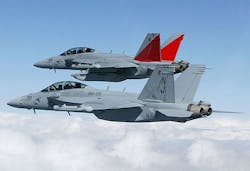Raytheon gets go-ahead to resume work on Next-Generation Jammer program after holdup lasting nearly seven months
Officials of the Naval Air Systems Command at Patuxent River Naval Air Station, Md., announced last week that they are confirming a $279.4 million contract to Raytheon awarded originally last July to build the Next-Generation Jammer (NGJ) to enable the EA-18G Growler carrier-based jet to jam enemy radar, communications, and other RF systems.
Raytheon rival in the NGJ competition, BAE Systems, formally protested the NGJ award to Raytheon shortly after the Navy announced the NGJ award to Raytheon. The BAE Systems protest held up development of one of the most important U.S. military EW programs for nearly seven months at a time when defense budget cutbacks were idling many of the nation's defense workers.
The NGJ is a project that analysts say could be worth billions of dollars in coming years. The NGJ is to go on the Navy EA-18G Growler EW jet, and its technology later could be applied to other aircraft, as well.
The resumed $279.4 million contract to Raytheon is for the technology development phase of the NGJ program to replace the legacy ALQ-99 tactical jamming system on the Growler carrier-based aircraft, which is based on the Boeing F/A-18 Hornet fighter-bomber.
Following the U.S. Navy's confirmation of its NGJ contractor last Monday, Raytheon officials announced their NGJ teams are ready to resume work on this critical electronic attack program for the warfighter, Raytheon officials say.
The Navy confirmed its choice of Raytheon, and rejected the BAE Systems protest, after the U.S. General Accountability Office (GAO), the investigative arm of Congress, conducted an assessment of the NGJ competition. Last November GAO auditors recommended the U.S. Navy re-evaluate proposals and document the evaluation record.
"We commend the GAO's thorough assessment of this contract award and the U.S. Navy's re-evaluation that has solidified us as the provider of the world's Next-Generation Jammer program," says Rick Yuse, president of Raytheon Space and Airborne Systems.
Eventually the NGJ program may expand to include an add-on electronic warfare (EW) jammer for the F-35 Raptor joint strike fighter that would not require a specially made EW aircraft like the EA-18 Growler.
The Navy's selection of Raytheon to build the NGJ is the result of a long competition for the program that pitted Raytheon against BAE Systems, ITT Exelis/Boeing, and Northrop Grumman.
Raytheon’s NGJ will provide airborne electronic attack and jamming capabilities, and will include cyber-attack capabilities that use the aircraft's active electronically scanned array (AESA) radar to insert tailored data streams into enemy systems.
The Raytheon NGJ will integrate advanced electronic attack technology into the EA-18G with a combination of high-powered, agile beam-jamming techniques, and solid-state electronics. The Raytheon NGJ also will have an open-systems architecture for future upgrades.
Eventually the NGJ may be fitted to unmanned aerial vehicles (UAVs) in addition to the EA-18G and F-35, as well as to other manned aircraft. Raytheon will use its gallium nitride (GaN)-based AESA technologies for the NGJ design.
The goal of the NGJ technology-development phase is to develop an electronic attack system that will improve airborne electronic attack capabilities against advanced threats through enhanced agility and precision within jamming assignments, increased interoperability, and expanded broadband capability for greater threat coverage against a wide variety of radio frequency emitters, Navy officials say.
On the NGJ contract Raytheon will do the work in El Segundo, Calif.; Fort Wayne, Ind.; Dallas; Torrance, Calif.; Clearfield, Utah; McKinney, Texas; Tucson, Ariz.; Marion, Va.; Goleta, Calif.; Forest, Miss.; and Andover, Mass., and could be finished by the end of 2015.
For more information contact Raytheon Space and Airborne Systems online at www.raytheon.com/capabilities/ew, or Naval Air Systems Command at www.navair.navy.mil.
About the Author
John Keller
Editor-in-Chief
John Keller is the Editor-in-Chief, Military & Aerospace Electronics Magazine--provides extensive coverage and analysis of enabling electronics and optoelectronic technologies in military, space and commercial aviation applications. John has been a member of the Military & Aerospace Electronics staff since 1989 and chief editor since 1995.
